1994 BUICK REGAL fuel
[x] Cancel search: fuelPage 14 of 308
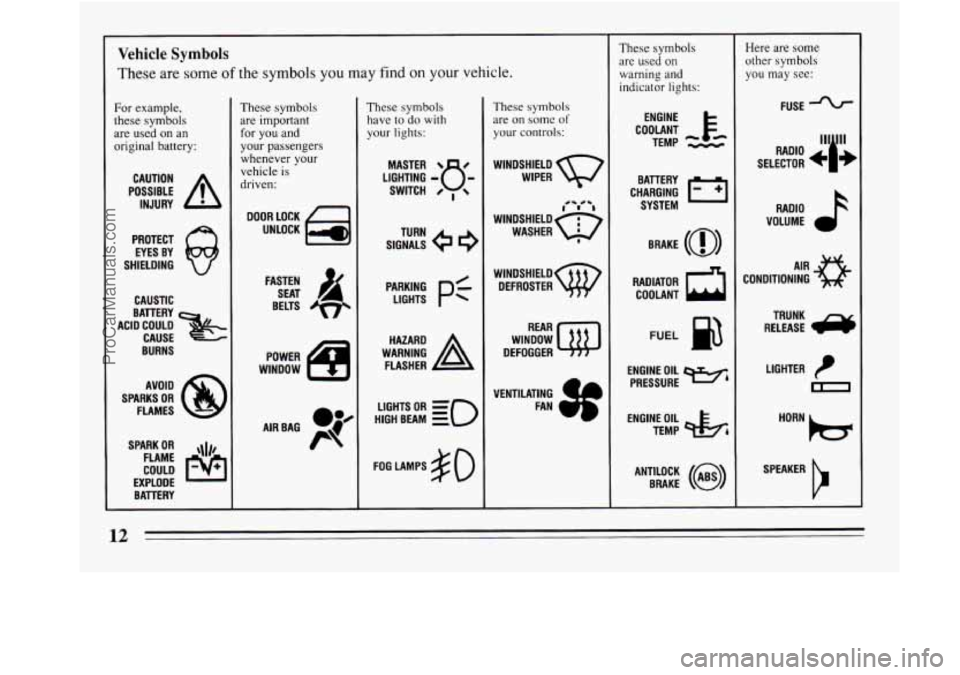
Vehicle Symbols
These are some of the symbols you may find on your vehicle.
For example,
these symbols
are used on an
original battery:
POSSIBLE A
CAUTION
INJURY
PROTECT EYES BY
SHIELDING
CAUSTIC
BURNS AVOID
SPARKS
OR
FLAMES
SPARK OR
,\I/,
FLAME
COULD
EXPLODE
BATTERY
These symbols
are important
for you and
your passengers
whenever your
vehicle is
driven:
DOOR LOCK
UNLOCK
FASTEN SEAT
4
BELTS
POWER
WINDOW
These symbols have
to do with
your lights:
SIGNALS e
TURN
WARNING
A
HAZARD
FLASHER
These symbols are on some
of
your controls:
WINDSHIELD WIPER Q7
WINDOW
DEFOGGER
VENTILATING FAN
HIGH BEAM
=
FOG LAMPS # 0
These symbols
are used
on
warning and
indicator lights:
CHARGING I-1
BATTERY
SYSTEM
RADIATOR COOLANT
FUEL
ENGINE OIL
PRESSURE
Wb
TEMP OIL &
ANTILOCK (a)
BRAKE
Here are some
other symbols
you may see:
FUSE
RADIO
>
VOLUME
CONDITIONING
AIR a
LIGHTER
m
SPEAKER
b
12
ProCarManuals.com
Page 80 of 308

PASS-Key@II
Your vehicle is
equipped
with the
PASS-Key@II
(Personalized
Automotive Security
System) theft deterrent
system. PASS-Key(%
is a passive theft
deterrFnt system. This
means you don’t have
to do anything different
to arm or disarm the
system.
It works
when you insert or remove the key from the
ignition. PASS-Key% uses a resistor pellet
in the
ignition key that matches a decoder
in your vehicle.
When the PASS-Key% system senses that someone
is
using the wrong key, it shuts down the vehicle’s starter
and
fuel systems. For about three minutes, the starter
won’t work and fuel won’t
go to the engine. If someone
tries to start your vehicle again or uses another key
during this time, the vehicle will not start. This
discourages someone from randomly trying different keys
with different resistor pellets in an
attempt to make
a match.
The ignition key must be clean and dry before it’s
inserted
in the ignition or the engine may not start. If the
engine does not start, the key may be dirty or wet. Turn
the ignition off.
Clean and dry the key. Wait about three minutes and
try
again. If the starter still won’t work, and the key appears
to be clean and dry, wait about three minutes and try the
other ignition key. At this time, you may also want to
check the fuse (see “Fuses and Circuit Breakers’’
in the
Index). If the starter won’t work
with the other key, your
vehicle needs service. If your vehicle does start, the first
ignition key may be faulty. See your Buick dealer or a
locksmith who can service
the PASS-Key@II.
If you accidentally use
a key that has a damaged or
missing resistor pellet, the starter won’t work. But you
don’t have to wait three minutes before trying one of
the
other ignition keys.
See your Buick dealer or a locksmith who can service
the PASS-Key(% to have a new key made.
If you lose or damage a PASS-Key% ignition key, see
your Buick dealer or a locksmith who can service
PASS-Key@II to have a new key made.
78
ProCarManuals.com
Page 83 of 308
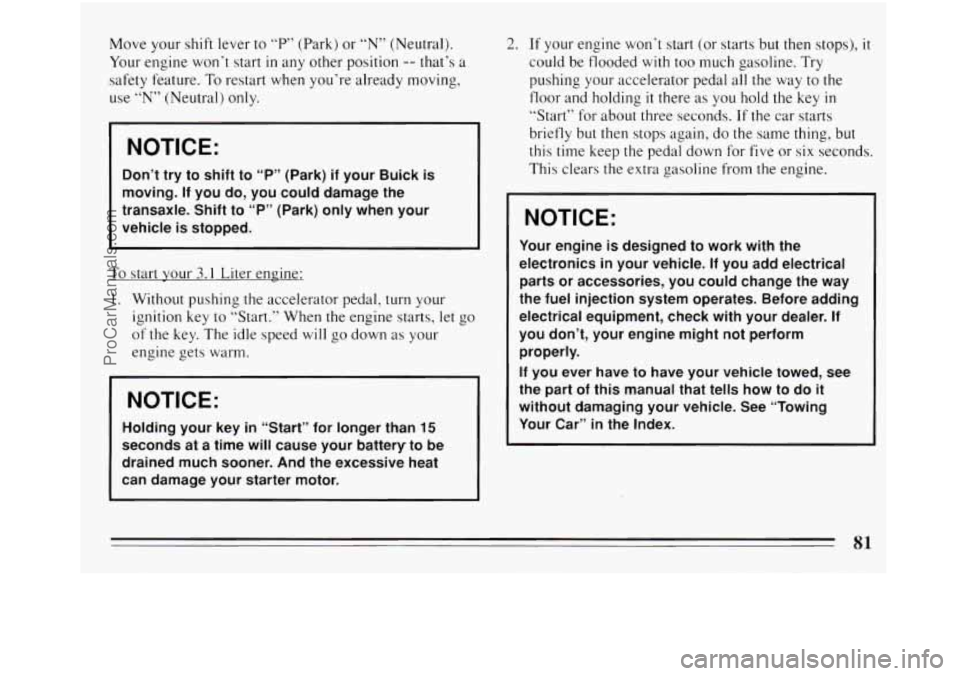
Move your shift lever to “P” (Park) or “N” (Neutral).
Your engine won’t start
in any other position -- that’s a
safety feature. To restart when you’re already moving,
use
“N” (Neutral) only.
NOTICE:
--
Don’t try to shift to “P” (Park) if your Buick is
moving. If you do, you could damage the
transaxle. Shift to “P” (Park) only when your
vehicle
is stopped.
To start your 3.1 Liter engine:
1. Without pushing the accelerator pedal, turn your
ignition key
to “Start.” When the engine starts, let go
of the key. The idle speed will go down as your
engine gets warm.
NOTICE:
Holding your key in “Start” for longer than 15
seconds at a time will cause your battery to be
drained much sooner. And the excessive heat
can damage your starter motor.
2. If your engine won’t start (or starts but then stops), it
could be flooded with too much gasoline. Try
pushing your accelerator pedal all the way to the
floor and holding
it there as you hold the key in
“Start” for about three seconds. If the car starts
briefly but then stops again, do the same thing, but
this time keep the pedal down for five or six seconds.
This clears the extra gasoline from the engine.
NOTICE:
Your engine is designed to work with the
electronics
in your vehicle. If you add electrical
parts
or accessories, you could change the way
the fuel injection system operates. Before adding
electrical equipment, check with your dealer. If
you don’t, your engine might not perform
properly.
If you ever have to have your vehicle towed, see
the part of this manual that tells how to do it
without damaging your vehicle. See “Towing
Your Car” in the Index.
81
ProCarManuals.com
Page 85 of 308
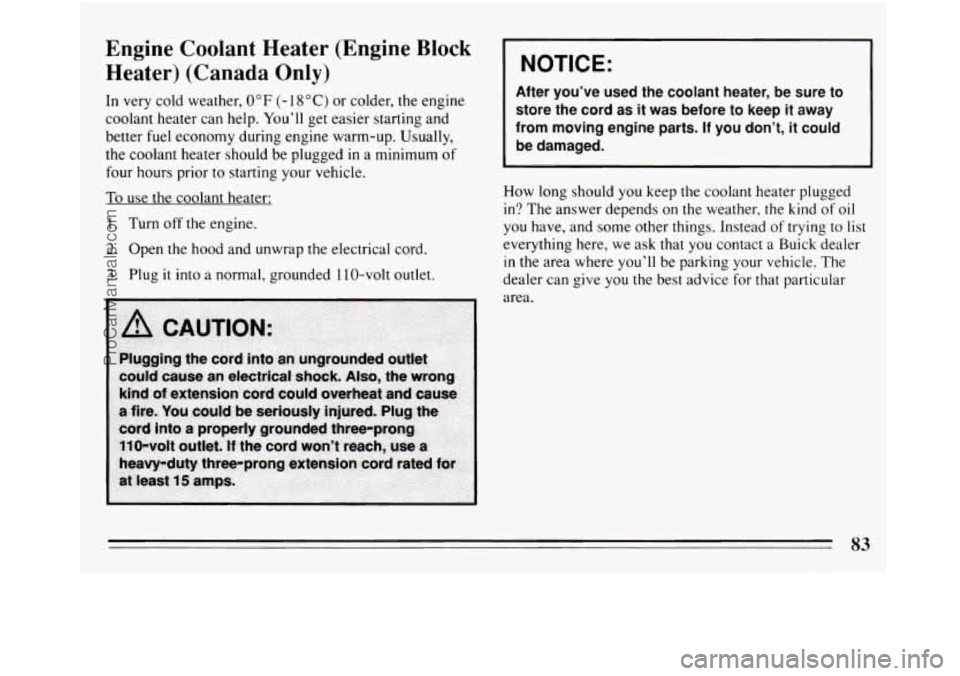
Engine Coolant Heater (Engine Block
Heater) (Canada Only)
In very cold weather, 0 "F (- 18 "C) or colder, the engine
coolant heater can help. You'll get easier starting and
better fuel economy during engine warm-up. Usually,
the coolant heater should be plugged
in a minimum of
four hours prior
to starting your vehicle.
To use the coolant heater:
1. Turn off the engine.
2. Open the hood and unwrap the electrical cord.
3. Plug it into a normal, grounded 110-volt outlet.
I NOTICE:
After you've used the coolant heater, be sure to
store the cord as it was before
to keep it away
from moving engine parts. If you don't, it could
be damaged.
How long should you keep the coolant heater plugged
in? The answer depends on
the weather, the kind of oil
you have, and some other things. Instead of trying
to list
everything here, we ask that you contact
a Buick dealer
in the area where you'll be parking your vehicle. The
dealer can give you the best advice for that particular
area.
83
ProCarManuals.com
Page 88 of 308
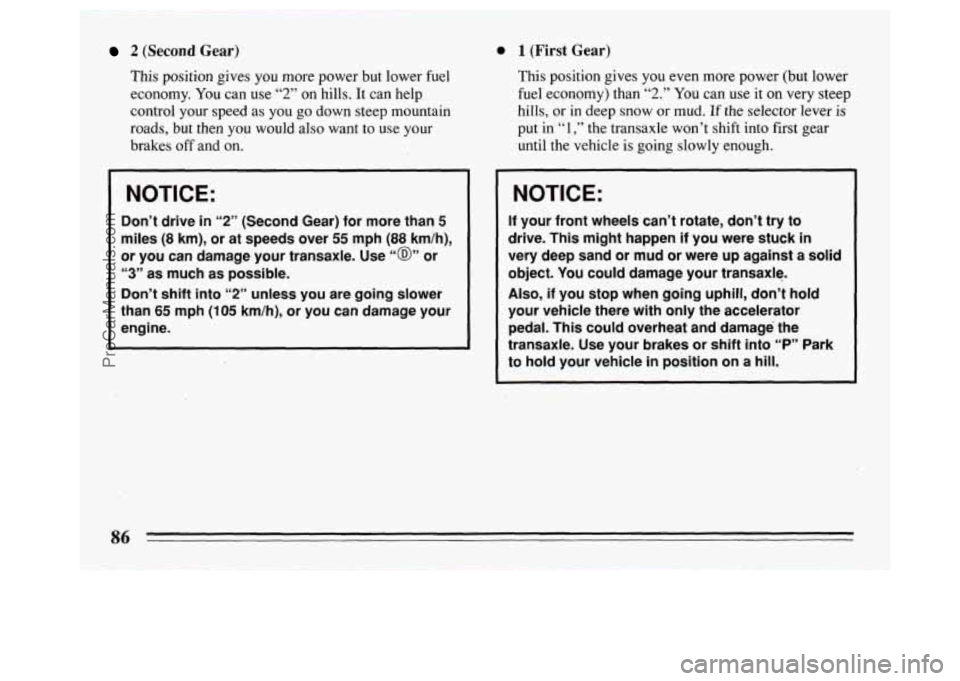
I
I
I
r
2 (Second Gear)
This position gives you more power but lower fuel
economy. You can use
“2” on hills. It can help
control your speed as you go down steep mountain
roads, but then you would also want to
use your
brakes
off and on.
0 1 (First Gear)
This position gives you even more power (but lower
fuel economy) than
“2.” You can use it on very steep
hills, or in deep snow or mud.
If the selector lever is
put in “1,” the transaxle won’t shift into first gear
until the vehicle is going slowly enough.
NOTICE:
Don’t drive in “2” (Second Gear) for more than 5
miles (8 km), or at speeds over 55 mph (88 km/h),
or you can damage your transaxle. Use ‘@” or
“3” as much as possible.
Don’t shift into “2” unless you are going slower
than
65 mph (105 km/h), or you can damage your
engine.
NOTICE:
If your front wheels can’t rotate, don’t try to
drive. This might happen if you were stuck
in
very deep sand or mud or were up against a solid
object. You could damage your transaxle.
Also, if you stop when going uphill, don’t hold
your vehicle there with only the accelerator
pedal. This could overheat and damage the
transaxle. Use your brakes
or shift into “P” Park
to hold your vehicle
in position on a hill.
86
ProCarManuals.com
Page 113 of 308
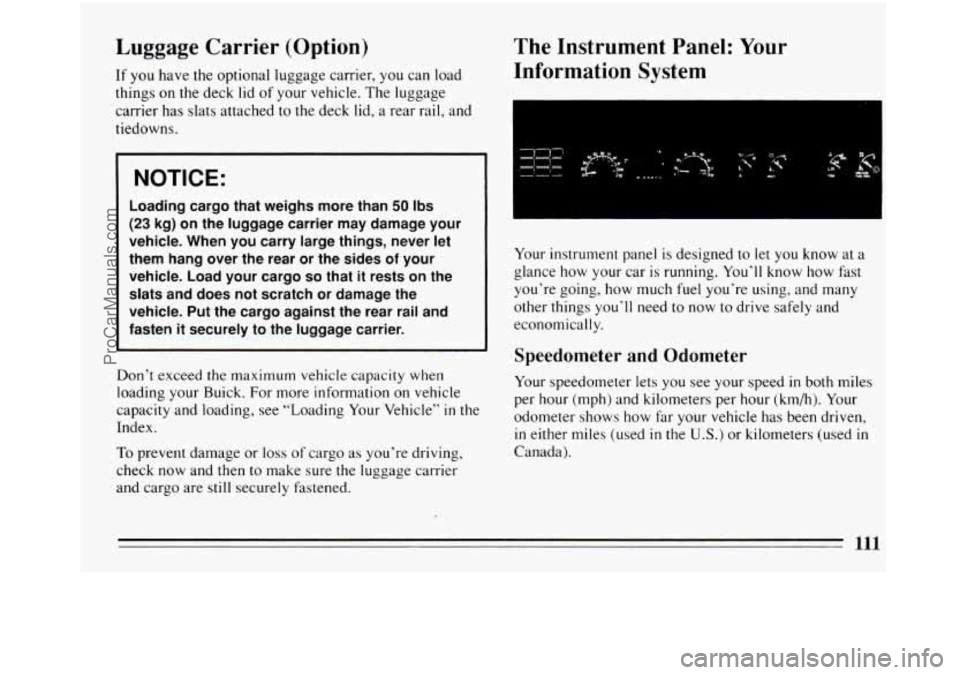
Luggage Carrier (Option)
If you have the optional luggage carrier, you can load
things on the deck lid of your vehicle. The luggage
carrier has slats attached to the deck lid, a rear rail, and
tiedowns.
NOTICE:
Loading cargo that weighs more than 50 Ibs
(23 kg) on the luggage carrier may damage your
vehicle. When you carry large things, never let
them hang over the rear or the sides of your
vehicle. Load your cargo
so that it rests on the
slats and does not scratch
or damage the
vehicle. Put the cargo against the rear rail and
fasten
it securely to the luggage carrier.
Don’t exceed the maximum vehicle capacity when
loading your Buick. For more information on vehicle
capacity and loading, see “Loading Your Vehicle”
in the
Index.
To prevent damage or loss of cargo as you’re driving,
check
now and then to make sure the luggage carrier
and cargo are still securely fastened.
The Instrument Panel: Your
Information System
I
Your instrument panel is designed to let you know at a
glance how your car is running. You’ll know how fast
you’re going, how much fuel you’re using, and many
other things
you’ll need to now to drive safely and
economically.
Speedometer and Odometer
Your speedometer lets you see your speed in both miles
per hour (mph) and kilometers per hour (km/h). Your
odometer shows how far
your vehicle has been driven,
in either miles (used in the U.S.) or kilometers (used in
Canada).
111
ProCarManuals.com
Page 115 of 308

When one of the warning lights comes on and stays on
when you are driving, or
when one of the gages shows
there may be a problem, check the section that tells you
what to do about
it. Please follow the manual’s advice.
Waiting to do repairs can be costly
-- and even
dangerous.
So please get to know your warning lights
and gages. They’re a big help.
Fuel Gage
Your fuel gage shows about
how much fuel is
in your
tank.
It works only when
the engine is on. When the
indicator nears
“E,” you
still have a little fuel left. Here
are some concerns owners have had about the fuel
gage. All these situations are normal and indicate
nothing wrong
with the fuel gage.
0
0
a
0
At the gas station, the gas pump shuts off before the
gage reads
“F”.
It takes more (or less) gas to fill up than the gage
indicated. For example, the gage indicated 1/2
full,
but it took more -- or less -- than half of the tank’s
capacity to
fill it.
The gage moves a little when you turn a corner,
speed
up, or stop your vehicle.
When you turn the engine off, the gage d&sn’t go all
the way back to
“E”.
113
ProCarManuals.com
Page 116 of 308
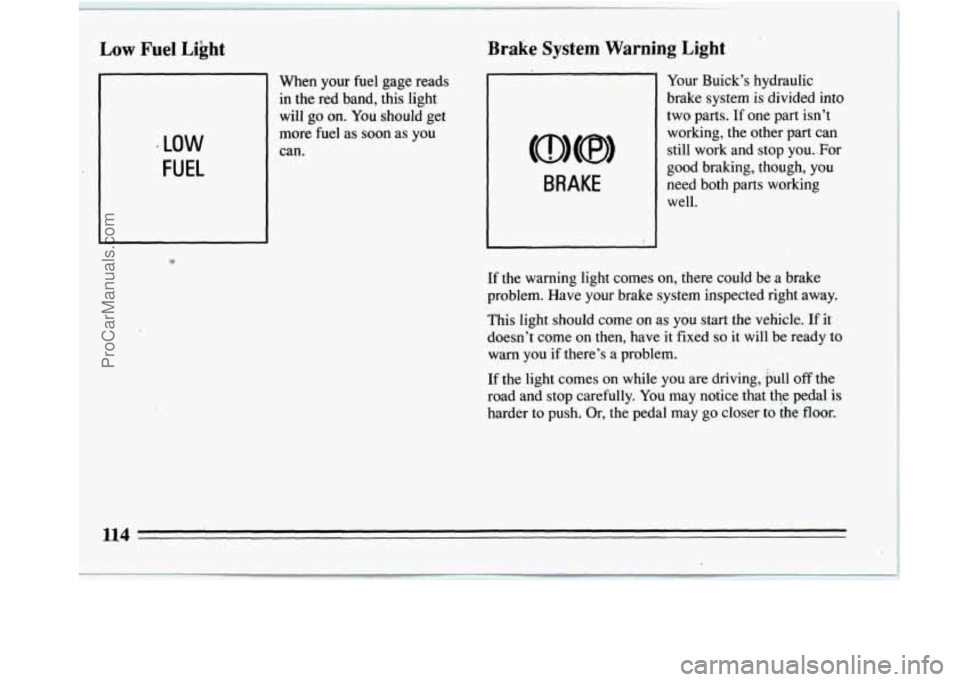
* LOW
FUEL
L
When your fuel gage reads in the red band, this light will
go on. You should get
more fuel
as soon as you
can.
Brake System Warning Light
BRAKE
Your Buick’s hydraulic
brake system is divided into
two parts. If one part isn’t
working, the other
part can
still work and stop you..For
good braking, though, you
need both parts working
well.
If the warning light comes on, there could be
a brake
problem. Have your brake system inspected right away.
This light should come on as you start the vehicle.
If it
doesn’t come on then, have it fixed
so it will be ready to
warn you if there’s a problem.
If the light comes
on while you are driving, pull off the
road and stop carefully. You may notice that the pedal is
harder to push. Or, the pedal may
go closer to the floor.
114
ProCarManuals.com